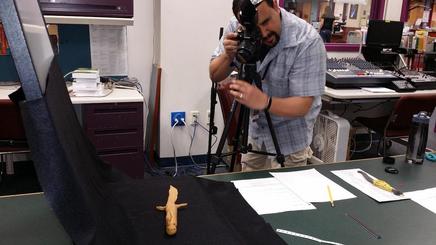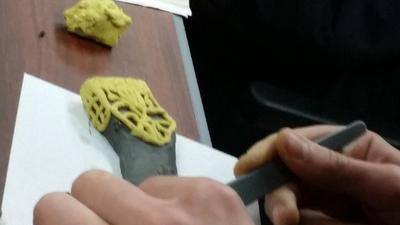and the recipient of a 2017 Web Seal of Excellence.
Seeds, unexpectedly, grow new ideas:
But it’s those seeds of new ideas that are planted (by my amazing librarian colleagues) that sometimes pop up unexpectedly as a solution to a new problem.
Here, at ARHS, our 9th grade Social Studies curriculum was revamped and a new component had students re-create Medieval Asian art. While talking to the department chair about this unit, I asked him how students would be accessing the materials for their art reproductions. The department had not had the time to figure this out, so I suggested we write a grant to our Parent Guardian Organization (PGO) to request funding for a cart and art materials. Thus, was born our makerspace “Go-Cart” and the beginning of a complex and intensely satisfying collaboration that involved not only myself and the Social Studies department chair and teachers, but that of my two talented library paraprofessional colleagues. The project grew and evolved to also tap into one of our less-used state database resources, the BiblioBoard “Content Creator”, which we used to publish photographs of the students’ reproductions.
Recognizing my colleagues’ skills, knowledge, and talents:
Writing the grant for the PGO required knowing exactly what we needed so we could present an accurate request for funding. I knew how to research mobile makerspace carts, but I knew nothing about art or the materials to reproduce it. Luckily for me, my coworker, Annie Figliola, is very knowledgeable in this area. She researched images of Medieval Asian Art from various regions of the world and then studied art supply catalogs carefully to select the materials to duplicate art from that period. She took into consideration colors of the periods, media to reproduce certain effects, and materials that would not leave stains in clothing or on furniture and floors. We presented this list of materials, with art images and explanations as to why they were selected, in our grant to the PGO. Happily, we were awarded a “Big Idea” grant for $1,200 and could proceed with the project! While Annie was researching the supplies the students would need, I put together a libguide which included a tab to help students search for art by region and timeline.
 Annie Figliola, “Ms. Fig”, demonstrating to students how art materials from the Library Go-Cart can be used to reproduce certain kinds of Medieval Asian Art.
Annie Figliola, “Ms. Fig”, demonstrating to students how art materials from the Library Go-Cart can be used to reproduce certain kinds of Medieval Asian Art.  Ken Ramos photographs students’ art reproductions.
Ken Ramos photographs students’ art reproductions. “Content Creator” is a feature in the state database, BiblioBoard, that offers a publishing option*. Students were informed at the beginning of the project that they could have their work photographed and published online. Thus began the next major phase of this project. Again, I am lucky to have skilled co-workers, and this time my other paraprofessional colleague, Ken Ramos, put his photography talents to work. Ken set up our small professional library as a photography lab and proceeded to photograph student creations. (Students signed permission forms to have their work published and those forms are kept on file in the librarian’s office.) The results were uploaded to BiblioBoard and were (in my opinion) spectacular! Here is the link to our students’ published work.
The Makerspace Go-Cart is now available for all departments to “check out.” Any department may write a small PGO grant to stock it with supplies for a class project and use it to integrate hands-on activities into their curriculum units!
*Unfortunately, Biblio Board's Content Creator is no longer paid for by the state and must be purchased as an add-on to BiblioBoard.



